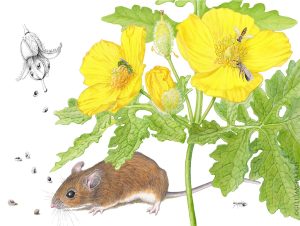Bloomington resident Gillian Harris, illustrator of the award-winning children’s book Wake Up, Woods, will be part of our Wake Up to Spring event at Oliver’s Woods this Sunday, along with Michael Homoya. Gillian’s stunning watercolors are a feast for the eyes. We asked her to share more about her work in this blog post.
How did you get your start illustrating the natural world?
I’m really interested in native plants, and I’ve been drawing all my life. I put the two together logically. I started out drawing more animals and then got more into botanical illustrations, which I enjoy.
What were your early professional experiences in illustrating?
When I moved to Michigan after going to graduate school to study English, I took a semester of independent study in science illustration at the University of Michigan. I was asked to be part of an illustrator consortium made up of mostly former and current grad students, working to put together a 12-volume encyclopedia of “animals of the world.” I just plunged into that. I had never done anything like it before. Photographs were our source material. I drew lemurs, neotropical bats, crows and jays.
But I was always interested in plants and wanted to get into that more. On a colleague’s recommendation, I looked into the American Society of Botanical Artists. It’s a wonderful resource. There’s an annual conference with workshops and presentations on techniques. They have international juried exhibits that travel to botanic gardens with exhibition space. My work has been in a couple of those.
How do you bring your passion to the work?
I love wild plants, and my preference is to illustrate them rather than cultivars, especially those plants indigenous to the Midwest. ASBA has put an emphasis on how botanical art serves science, and on educating people about plants as part of ecosystems, in addition to portraying garden flowers and cultivars for their beauty alone. The first ASBA exhibit I entered, with a painting of goldenseal (Hydrastis canadensis) was called Losing Paradise, and featured threatened and endangered plants here and around the world.
Do you feel like a daughter to the naturalist women who historically drew plants?
Among most botanical artists there is a sense of continuing an artistic tradition, and an awareness that women historically played a great part in that tradition and that some of the best botanical artists were—and are today—women. Maria Sybella Merian, for example.
Beatrix Potter is famous for Peter Rabbit, but she also did wonderfully realistic paintings of mushrooms and serious studies of rabbits. But because she wasn’t scientifically trained, this work was never accepted as important or worthy of consideration.
How did you end up doing illustrations for Wake Up, Woods?
I have been a member of the Indiana Native Plant Society for quite a while. Ruth Ann Ingraham (an INPS board member), Melissa Moran and Carolyn Walmsley initiated the idea of doing a children’s book sponsored by INPS. (Coauthor) Shane Gibson, who had written a few poems already, was meeting with Ruth Ann and Melissa at the Sycamore Land Trust headquarters in Bloomington. I happened to walk in on the meeting, as I was returning materials from a lichen walk I had led the day before. I sat down with them and pretty soon I came on board. Then later Ruth Ann asked Mike Homoya to contribute the factual information.

You show a lot of “critters” in the book as well as plants!
I had some knowledge of pollinator-plant interactions and seed dispersal by ants. I was eager to work in as many insects and other animals as possible. Since I wasn’t working in the springtime, I drew and painted everything from photographs—mostly my own.
What specific design choices did you make in the book?
If the entire plant is depicted, sometimes the flower doesn’t show up well. We decided to focus in on each flower and make it bigger and bolder, since it’s a children’s book, and not a field guide. So I included enough leaves to make them identifiable, but concentrated on the flowers themselves—their colors and how they’re constructed. Patricia Prather then designed the book, putting text and artwork together and creating the overall look.
What are you working on now?
I’m working on technical botanical illustrations for the director of the IU Herbarium—pen and ink illustrations of African lobelias. For reference I’m using photos he took of the plants in situ, as well as dried flat herbarium specimens and photos taken through a microscope.
What is the overall goal for Wake Up, Woods?
To create a curiosity about native wildflowers and a desire to get out into the woods and see them, and a realization of how they function in the ecosystem as the basis for all the insect, bird and other animal life out there. Bugs and frogs sometimes appeal to kids more than plants, and we hoped to show how all these creatures rely on and interact with native plants—leading to an appreciation of native flora and a desire to protect and conserve it.
Read more from Gillian and find her beautiful artwork at her website.

Shawndra Miller
Communications Director